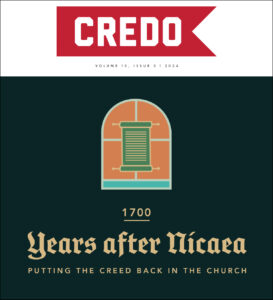In an earlier essay, Luke Stamps and I gave three reasons we support adding the Nicene Creed to the Baptist Faith & Message (2000).[1] To sum it up, it is our conviction that this decision is biblical, Baptist, and beneficial.
Including the Creed Is Biblical, Baptist, and Beneficial
We believe, first of all, that this change is entirely biblical. This is because the Nicene Creed itself is rooted in Scripture and is an accurate summary of the doctrinal content of God’s Word, especially regarding the nature of the Triune God. As we state in that earlier piece,
As each generation of Christians since the fourth century has rightly noted, the Nicene Creed’s statements are thoroughly biblical. It covers the full slate of major loci in Christian theology – the Trinity, Christology, salvation, creation, Scripture, the church, and the last things. To take the Creed’s focal point as ours, its phrases concerning the Triune God, Father, Son, and Holy Spirit, are derived from and grounded in Holy Scripture.
Baptists throughout our history have found it appropriate to affirm the Nicene Creed both personally and corporately. Share on XSecond, we believe this change is grounded in Baptist precedent. From the Orthodox Creed of the General Baptists and the Second London Baptist Confession of Faith of the Particular Baptists in the seminal 17th century of Baptist thought, through Hercules Collins and John Gill, and all the way to WA Criswell, Baptists throughout our history have found it appropriate to affirm the Nicene Creed both personally and corporately. Or, as Luke and I put it,
In sum, the most influential confessions in Baptist history have been directly dependent upon creedal language, and at least two important Baptist symbols have included the full text of the creeds themselves. If we look beyond the confessional tradition to individual Baptist theologians, we see the same pattern emerge.
Reference to, use of, affirmation of, or inclusion of the Nicene Creed would thus not be new to Baptist life but in many ways a return to our roots – confessionally orthodox and Protestant with respect to the Trinity, Christology, and soteriology, as well as distinctively Baptist with respect to ecclesiology.
A final reason that Luke and believe that this is worthy of consideration is because the Nicene Creed is beneficial to discipleship in the local church. To quote that earlier essay one last time,
If Baptists were to explicitly affirm the Creed, teach it in our churches, and even recite it together in our worship services, it would go a long way toward inoculating us from erroneous views about the trinity. The Creed teaches us the language of carefully worded biblical orthodoxy. As such, it provides a time-tested framework for interpreting and applying God’s word to our lives. Affirming the biblical truths summarized in the Creed will aid our prayer life, our worship, our evangelism, our preaching, our counseling, our discipleship, and more.
All of this, though, is really a precis to the point of this essay. Despite the biblical, Baptist, and beneficial rationale for doing so, many of our fellow Baptists have deep and serious reservations about making such a decision. There are a variety of reservations, but here I want to address just one – the Nicene Creed’s statement on baptism.
“Baptism for the Forgiveness of Sins”
For many of our Baptist brethren, this line brings heightened confusion and consternation. On the face of it, this sounds to some like an affirmation of baptismal regeneration. Whether the Roman Catholic or Stone-Campbellite variety, Baptists have historically rejected this position on baptism even while they retain their emphasis on the importance of the act itself. Rather than being an obstacle to Baptist affirmation of the Nicene Creed, however, I want to argue that this phrase is most faithfully (biblically & theologically) and historically expressed when done so by Baptists.
I will begin with the latter category, namely the historical meaning of the phrase at the time of the Creed’s affirmation.[2] As Everett Ferguson has observed, baptismal practice in the early church was not nearly as uniform as contemporary paedobaptist proponents would like. To put the point succinctly, the evidence points to adult baptism being the most likely norm in the first century or two, and afterward shifting rapidly to paedobaptism due to soteriological concerns, rather than paedobaptism being the norm from the beginning. We see this in a number of ways. First, the construction of baptism fonts is telling. Many of those that remain from the early centuries of the church are clearly designed for an adult pastor to baptize an adult baptizand via immersion. While this could certainly accommodate paedobaptism, the norm is not a small font stand that will normally be used for affusion or sprinkling an infant, but a large baptismal pool that is normally used for adults. This does not preclude paedobaptism, but it does suggest that paedobaptism was not necessarily yet the norm.[3]
Second, regarding the theology of baptism in the early church, the early church viewed baptism as serving “six purposes: the forgiveness of sins; deliverance from death; regeneration, or the new birth; the gift of the Holy Spirit; the renunciation of Satan; and identification with Jesus Christ.”[4] We will explore the biblical warrant for these claims below; suffice it to say that the narrative of Acts, along with passages like John 3:5; Rom. 6:1–4; and Titus 3:5, served as foundations for these affirmations. None of these require affirmation of what we would now call baptismal regeneration, though. Baptists, too, especially in their first century or two of existence, were willing and able to affirm those same purposes. We will explore this more in the next section of the essay.
The “baptism” of the crossing of the Red Sea prefigures baptism as the sign of the new covenant, in which all those who believe are united with Christ through the Spirit. Share on XFinally, the concern about baptismal regeneration being the original intent of the creedal clause is interesting given the timing of that doctrinal position’s widespread prominence in the early church. Arguably it was Augustine who made the definitive arguments for baptismal regeneration in relation to his strong stance on original sin, arguments that would solidify paedobaptism as the practice of the Medieval church and lead to the soteriological constructions related to the sacraments that would prompt the Reformation a millennium later. Augustine, of course, wrote in the early to mid-fifth century, while the Nicene Creed was first adopted in 325 and then modified into its final form in 381 at the First Council of Constantinople. While it is quite possible that there was a latent version of baptismal regeneration percolating in the early fourth century,[5] it certainly was not the uniform view of the church in terms of codified doctrine. It was not until Augustine a century later that it would be widely distributed among Western churches, and, again, this was really in relation to Augustine’s debates with Pelagius about original sin.[6] In other words, even the adoption of baptismal regeneration was not in relation to the consideration of baptism per se but as a derivative position based on Augustine’s position on original sin and its remedy within a nascent Roman ecclesiology.
The point, then, is simple – the creedal clause is not necessarily an explicit affirmation of either paedobaptism or baptismal regeneration. In fact, the evidence points to the opposite being the case. As Everett Ferguson says in his massive tome on baptism in the early church,
The fact is that ‘we cannot give the name of anyone before the fourth century not in an emergency situation who was baptized as an infant.’ . . . The liturgy and theology of baptism, as well as the practice of leading Christian families, show that in the fourth century infant baptism was not yet the norm. The situation began to change late in the fourth century.[7]
We can conclude, then, that the early church took at least four centuries to conclude that paedobaptism was the correct practice, and this was in concert with baptismal regeneration becoming prominent and explicitly affirmed as a doctrinal position related to soteriological and sacerdotal developments. These two – practice and doctrine – go hand in hand. To conclude, then, that the phrase in the Nicene Creed is an explicit affirmation of paedobaptism or baptismal regeneration is anachronistic. Instead, rather than affirming paedobaptism or even an explicit theology of baptism, the Creed’s authors included a quote from the Bible to affirm the place of baptism in the church and left it at that. This means that the clause is a baseline affirmation of baptism, not a doctrinally loaded and ecclesiologically idiosyncratic statement. This means that it is a statement that can and should be widely affirmed by the whole church, not a statement that is articulating one particular tradition’s or denomination’s views on baptism.
Historical Baptist Position on Baptism
This theological space given by the creedal clause’s barebones and biblically-derived phrasing means that the question is not, “Should we confess it as Baptists?” but instead, “Exactly what are we confessing when we affirm it?” At the most basic level, and as the Creed indicates, we are confessing simply what the Bible states. We believe in “baptism for the forgiveness of sins,” which is simply a direct quote of Acts 2:38. The full verse is Peter’s instructions to the men who hear his message and ask how to be saved. Peter tells them, “Repent and be baptized every one of you in the name of Jesus Christ for the forgiveness of your sins, and you will receive the gift of the Holy Spirit.” As the Southern Baptist New Testament scholar and former Southern Seminary professor Bob Stein has noted,
In Acts the forgiveness of sin is also associated with being baptized. Peter’s instructions to those seeking forgiveness of sins is ‘Repent and be baptized every one of you in the name of Jesus Christ for the forgiveness of your sins, and you will receive the gift of the Holy Spirit (2:38). Although some have sought to interpret the expression ‘for [eis] the forgiveness of your sins’ as ‘in the hope of forgiveness’ or ‘because of your forgiveness,’ it is best to interpret the expression as indicating the purpose of repentance-baptism.
. . . A number of scholars have argued that the expression ‘for the forgiveness of sins’ should be understood as modifying only the verb ‘repent.’ Yet the separation of the verbs ‘repent’ and ‘be baptized’ into two independent actions views these commands from the perspective of later church practice rather than the understanding of their interrelatedness in Acts, where they are intimately associated in time and effect.[8]
As Stein concludes later on in the chapter, conversion includes in Acts “five integrally related components” which “took place at the same time, usually on the same day: repentance, faith, confession, receiving the gift of the Holy Spirit, and baptism.”[9] Stein is careful to qualify that baptism by itself never brings about salvation, but is the outward sign, along with the outward declaration of confession, of the inward realities of repentance, faith, and regeneration.[10] But his point remains that, in Acts, conversion is a matrix of salvation that includes both inward change (repentance, faith, regeneration) and outward expression (confession, baptism).
This relation of baptism to conversion is evident elsewhere in Scripture. For instance, Paul ties the imagery of baptism – figured death and resurrection via immersion in water – to the believer’s death to sin and spiritual resurrection to new life in conversion by the Spirit in Romans 6:1–4. He makes a similar connection in 1 Corinthians 10 when he talks about Israel being “baptized in the cloud and the sea” (10:2) in the exodus. Of course, given the shift from the old covenant to the new covenant, this is not the same as baptism in the New Testament. But the point is the same – the “baptism” of the crossing of the Red Sea, in which Israel was constituted as a distinct nation or people, prefigures baptism as the sign of the new covenant, in which all those who believe are united with Christ through the Spirit (cf. John 3:5).
The early British Baptists, and many of their Baptist progeny around the world, recognized this tight connection between the outward sign of baptism and the inward change of the new believer, what we call conversion. This inward change, as Peter notes in Acts 2:38, consists namely of the forgiveness of sins and the indwelling of the Holy Spirit. The following are quotes from early Baptist confessions that demonstrate this baseline affirmation of the biblical view of baptism:
- In “A Short Declaration of Faith of English People Remaining at Amsterdam in Holland” (1611), baptism is described as “the outward manifestacion off dieing vnto sinn, and walke-ing in newness off life” (art. 14).
- In “The Orthodox Creed” (1660), baptism is described as a “sign of our entrance into the covenant of grace, and ingrafting into Christ, and into the body of Christ, which is his church; and of remission of sin in the blood of Christ, and of our fellowship with Christ, in his death and resurrection, and of our living, or rising, to new-ness of life” (art. XXVIII).
- According to the First London Baptist Confession of Faith (1644), baptism, “being a signe, must answer the thing signified, which are these: first, the washing the whole soule in the bloud of Christ. Secondly, that interest the Saints have in the death, burial, and resurrection; thirdly, together with a confirmation of our faith, that as certainly as the body is buried under water, and riseth againe, so certainly shall the bodies of the Saints be raised by the power of Christ, in the day of the resurrection, to reigne with Christ” (Article XL).
- Similarly, the Second London Baptist Confession of Faith (1689) says that baptism is a “sign of his [the believer’s] fellowship with him [Christ], in his death, and res-urrection; of his being engrafted into him; of remission of sins; and of his giving up unto God through Jesus Christ, to live and walk in new-ness of life” (art. XXIX.1).
Conclusion
Each of these, along with others, demonstrates that early Baptists were entirely comfortable speaking of baptism “for the remission of sins.” This is because the phrase, as entirely biblical, is a succinct summary of the Bible’s theology of baptism. It is an external sign of an inward reality and as such communicates publicly and is intricately connected to the “matrix of salvation” that is conversion. Baptists can feel comfortable confessing it along with the rest of Christ’s church, even if we differ over aspects of the theology and practice of baptism.
In fact, Baptists of all people should be most comfortable affirming this clause, since believers’ baptism is the only position that holds together tightly that “matrix of salvation” in the NT as noted by Stein: repentance, faith, regeneration, confession, and baptism. While paedobaptists separate, at least temporally, these elements, Baptists do not put asunder what God has joined together in the act of conversion. The external expressions of salvation – confession and baptism – are joined in both concept and time, as intended, with the inward change of a person’s heart through repentance, faith, and regeneration. In this respect, Baptists can and should confess “baptism for the remission of sins.”
Notes:
[1] See also Luke Stamps’ additional essay on the baptism clause, “ ‘One Baptism for the Remission of Sins’: Baptists and the Baptism Clause.”
[2] For a brief discussion of a history of baptism in the early church, see my “Baptists, Baptism, and the Christian Tradition,” pp. 181–204 in Matthew Y. Emerson, Christopher W. Morgan, and R. Lucas Stamps, eds., Baptists and the Christian Tradition: Towards an Evangelical Baptist Catholicity (Nashville: B&H Academic, 2020), 185–87.
[3] Everett Ferguson discusses baptismal fonts throughout his extensive study on baptism in the early church. On this point, one might begin with the images includes in the middle of the book and then refer to the chapters on the various geographical locales indicated in the captions. See Everett Ferguson, Baptism in the Early Church: History, Liturgy, and Theology in the First Five Centuries (Grand Rapids: Eerdmans, 2009), pp. 451–455. Tertullian’s oft-quoted concerns about infant baptism can be added to this point. See ibid., 362–66.
[4] Gregg R. Allison, Sojourners and Strangers: The Doctrine of the Church, Foundations of Evangelical Theology (Wheaton, IL: Crossway, 2012), 325. Allison cites Tertullian, Against Marcion 1.28, for the first four purposes. In support of the latter two, he cites Tetullian, The Shows, and Basil the Great, On the Spirit 15.35, in Gregg R. Allison, Historical Theology (Grand Rapids: Zondervan, 2011), 614–15.
[5] See, for instance, Origen, Homilies on the Gospel of Luke, 14:5, cited in Allison, Sojourners and Strangers, 327–28; and Cyprian, Letters 58.2; 58.5, cited in Allison, Sojourners and Strangers, 328. See also Everett Ferguson’s discussion of sickbed baptism in Baptism in the Early Church, 617–26. Ferguson quotes in this regard the Cappadocian Fathers as well as John Chrysostom, and to the effect that these fourth century theologians saw a tight correlation between salvation and baptism, so much so that they urged against delaying baptism, particularly in the face of life-threatening illness. As we will see below, though, this tight correlation between baptism and salvation is not necessarily an affirmation of baptismal regeneration, but rather (at the very least) simply an affirmation of the New Testament’s own description of the matrix of salvation.
[6] See, for instance, Augustine, On Marriage and Concupiscience 2.51, and On Original Sin, 21, cited in Allison, Sojourners and Strangers, 328–29. See also on this point Ferguson, Baptism in the Early Church, 627–28.
[7] Ferguson, Baptism in the Early Church, 379. See also ibid., 856–57.
[8] Robert H. Stein, “Baptism in Luke-Acts,” pp. 35–66 in Thomas R. Schreiner and Shawn D. Wright, eds., Believer’s Baptism: Sign and Seal of the New Covenant in Christ, NAC Studies in Bible & Theology (Nashville: B&H Academic, 2006), 49.
[9] Stein, “Baptism in Luke-Acts,” 52.
[10] Stein, “Baptism in Luke-Acts,” 52–58.



